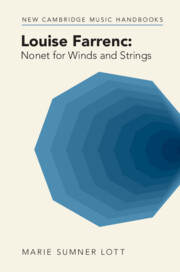
-
Select format
-
- Publisher:
- Cambridge University Press
- Publication date:
- October 2025
- October 2025
- ISBN:
- 9781009415446
- 9781009415453
- 9781009415477
- Dimensions:
- (216 x 140 mm)
- Weight & Pages:
- 0.5kg, 160 Pages
- Dimensions:
- (216 x 140 mm)
- Weight & Pages:
- 0.22kg, 160 Pages
- Series:
- New Cambridge Music Handbooks
You may already have access via personal or institutional login- Series:
- New Cambridge Music Handbooks
Book description
As well as being a virtuoso pianist, Louise Farrenc became the first woman to hold a permanent position as Professor at the Paris Conservatoire while continuing to compose symphonic and chamber music. This handbook introduces readers to Farrenc and her contemporaries with a focus on professional women musicians in nineteenth-century Paris. Farrenc's music was much admired by her contemporaries including Robert Schumann and Hector Berlioz. The acclaimed Nonet (1849) incorporated playful dialogue within the ensemble, virtuosic display, and an artful balance of newer and older compositional methods, garnering critical and artistic success and official recognition for the composer. Its performance history shows how musicians managed the logistics of professional life: forming and sustaining relationships, organizing concerts and tours, and promoting their work in the musical press. The book's nuanced analytical approach and historical insights will allow students, performers and listeners a fresh appreciation of Farrenc's work.
Contents
Metrics
Altmetric attention score
Full text views
Full text views help Loading metrics...
Loading metrics...
* Views captured on Cambridge Core between #date#. This data will be updated every 24 hours.
Usage data cannot currently be displayed.
Accessibility standard: Missing or limited accessibility features
Why this information is here
This section outlines the accessibility features of this content - including support for screen readers, full keyboard navigation and high-contrast display options. This may not be relevant for you.
Accessibility Information
The PDF of this book is known to have missing or limited accessibility features. We may be reviewing its accessibility for future improvement, but final compliance is not yet assured and may be subject to legal exceptions. If you have any questions, please contact accessibility@cambridge.org.
Content Navigation
Table of contents navigation
Allows you to navigate directly to chapters, sections, or non‐text items through a linked table of contents, reducing the need for extensive scrolling.
Index navigation
Provides an interactive index, letting you go straight to where a term or subject appears in the text without manual searching.
Reading Order and Textual Equivalents
Single logical reading order
You will encounter all content (including footnotes, captions, etc.) in a clear, sequential flow, making it easier to follow with assistive tools like screen readers.
Short alternative textual descriptions
You get concise descriptions (for images, charts, or media clips), ensuring you do not miss crucial information when visual or audio elements are not accessible.
Visual Accessibility
Use of colour is not sole means of conveying information
You will still understand key ideas or prompts without relying solely on colour, which is especially helpful if you have colour vision deficiencies.
Structural and Technical Features
ARIA roles provided
You gain clarity from ARIA (Accessible Rich Internet Applications) roles and attributes, as they help assistive technologies interpret how each part of the content functions.

